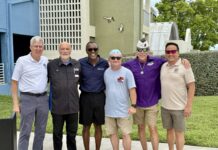
Before Fred the Tree sprouted on the Old Seven Mile Bridge, becoming an iconic landmark for drivers traveling along the Florida Keys Overseas Highway, our highway landmark was Fat Albert.
Named for a large and ungainly animated character in a children’s television series, our Fat Albert was (and still is) a large and ungainly white blimp floating high above the Lower Keys.
Albert is technically a tethered aerostat — a 180-foot-long helium radar balloon that provides high-tech surveillance of air traffic and maritime activity. The so-called blimp is obviously inanimate, but given its nickname, masculine pronouns have long been used to describe it.
Local lore back in the early ’80s suggested that Albert had other “missions” too — and it’s well-documented that, for a while, he transmitted the United States’ TV Marti television signal to Cuba.
Unlike Fred the Tree, who remains firmly rooted to the old bridge, Fat Albert drifts in the sky above the Lower Keys. Moored by a heavy-duty tether or cable, he’s supposed to float at some 10,000 feet over an area determined by the limits of the “leash.”
One day in the summer of 1981, however, Fat Albert had a surprise for his handlers — and pretty much everybody else in the Keys.
A few of us were gathered at the Chart Room for cocktails when the news broke. A tiny bar at the Pier House resort, the Chart Room was one of the centers of our Key West universe.
I was perched on a barstool listening raptly to one of the notables who frequented the place, still awed by the power he and his cohorts represented. Locals joked that the city, police and sheriff’s departments and state attorney’s office operated from the Chart Room.
They weren’t exactly wrong. In those days, you could find more politicos at the bar’s wooden spool tables than you could at City Hall.
Naturally, it was the politicos — including the state attorney at the time — who first got word about the “incident” involving Fat Albert.
Perhaps because the bartenders prided themselves on serving strong cocktails, few people could keep a secret at the Chart Room. Moments later, we all knew: Fat Albert had slipped his “leash” and was floating free over the Lower Keys, headed for the vast open sky above the Gulf of Mexico.

Slowly the details trickled in. The “incident” had occurred while the blimp’s handlers were pulling him down from the sky because of approaching thunderstorms. As they released helium, the tether cable dragged along the water until all hell — and Fat Albert — broke loose.
The escape, it emerged, was only half the story. Four local guys in a boat spotted the runaway blimp trailing its tether and tried to save the day. They chased down the “leash,” affixed it to their 23-foot boat, and attempted to tow Albert back to its home base.
Unfortunately Albert was far bigger and heavier than their vessel, and he was moving fast. Hooked to the tether, the boat was lifted into the air. The four guys found themselves dumped into the water but were fortunately unscathed.
The volume inside the Chart Room increased quickly as the regulars debated who could possibly be crazy enough to think a small boat could capture Fat Albert.
Suddenly the state attorney’s 20-something son and his best friend burst through the bar’s doorway, disheveled and clearly giddy with adrenaline — announcing that nobody would believe the adventure they just had on their boat.
So what happened to Fat Albert? The Air Force eventually found the escaped blimp 165 miles west of Key West, cruising merrily along at an altitude of 25,000 feet. Launching a rescue mission whose details remain murky even now, they brought the wayward Albert home.




















